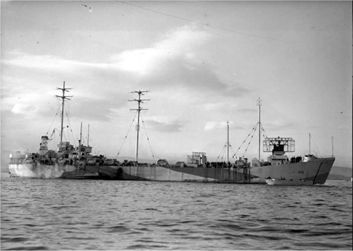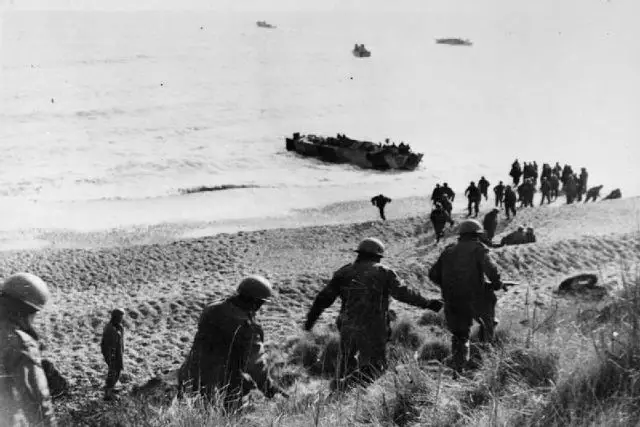Ahead of the D-Day 75 Off Ventnor event, David Baldwin shares with us this fascinating background to Ventnor and the Isle of Wight’s involvement in the the largest seaborne invasion in history. Ed
Lord Louis Mountbatten was tasked by Churchill back in 1941, in the darkest days, with devising offensive operations in the form of an invasion force to cross the Channel by air and sea to bring about the liberation of occupied Europe.
The nation was in every other quarter engaged in defensive mode to stave off the real and immediate threat of invasion of our own land.
Every life would depend on the operation
The Combined Operations role had begun as a paper exercise before his appointment, but upon his new direction of it, every life would depend come the day, even though Mountbatten was fighting in the Far East during D-Day operations in Europe.
But under Mountbatten, before his appointment to the Far East in August 1943, numerous operational requirements were conceived covering radar development, inventions, black ops, deception, diversification of factory and shipyard production of aircraft, ships, tanks, and conventional weaponry and the unorthodox.
Uffa Fox trialed survival craft at Puckaster
While Barnes Wallace was developing the bouncing bomb to breach the dams along the Ruhr, Uffa Fox (from Cowes) was busy at Puckaster Cove below Niton developing and trialling survival craft that could be deployed from the air.
Ventnor hosted a radar establishment that incorporated the pioneering radar developments conceived at Bawdsey Manor at Orford Ness.
Radar inventions
Some of these inventions were owed to the efforts of British military raiding parties such as those on Bruneval in 1942, where parts of the German radar installations were physically unbolted and smuggled back to Bawdsey Manor for detailed examination and adaptation.
A particularly valuable physical retrieval operation of the 1939 German Dete1 version of Seetakt 15 mile range radar was carried out by Scientific Officer, Mr Labouchere Bainbridge-Bell, one of the British principal inventors of RADAR, in the River Plate on the listing, scuttled wreck of the Graf Spee.

The Wuertzberg and Freya radars developed by the Germans were so efficient at ship and aircraft discovery and gun-ranging that the British incorporated some of their technology into both our shipborne and air detection radar at sea and over land. The Germans even had a vessel in 1940, ‘Togo’, that sported a Freya radar on the bow, a Wuertzburg-Riese on the stern and two Y-Stations a midships.
Vital role of systems in D-Day operations
The Royal Navy deployed similar inventions from 1940, but not radar gun-laying capability until as late as 1941. After that the British quickly developed other pulse and passive systems that were superlatively ingenious and played vital roles in D-Day operations both at sea and on land.

Note the similar concept to the 1940 German ‘Togo’ for British/Canadian seaborne deployment of radar for detection and range finding in 1944.
Deployed to secret locations after Ventnor
HMS 216 (pictured above) and three other similar specialist Royal Navy craft were to deploy off the Normandy Coast in support of the landings, where RAF Ventnor could not be expected to disentangle cluttered skies and ships at close range, at such a distance across the Channel with any degree of timely response.
These craft, deploying largely specialist Royal Canadian Air Force Officers, sailed into Zone Z off Ventnor before deploying to their secretive locations in the Channel.
Centimetric radar was the most successful against U Boats, best deployed aboard Seaplanes with long endurance.
Pioneering work at RAF Ventnor and St Lawrence
Nearly all the radar inventions were deployed at one time or another at RAF Ventnor and these proved vital defensive and offensive capabilities as the War progressed and D-Day preparations coalesced.
RAF Ventnor and RAF St Lawrence between them were thus able to deploy Chain Home, Chain Home Low and Chain Home Extra Low and an extraordinary range of pioneering variants.
Other secret locations
Other locations in Ventnor of an even more secret nature had vital roles, as did other locations across the Isle of Wight with their crucial specialism too in support of Operation Overlord.
D-Day 75 Off Ventnor: All welcome
You can witness a very special commemoration service in Ventnor on Wednesday 5th June 2019.
300 veterans on board a liner heading for Normandy will stop off the Ventnor coast to take part. You can from the shoreline between 8.45pm and 9.15pm.
Full details provided here. You’ll be able to purchase a £1 commemorative booklet at the event on Ventnor seafront, which has more background of Ventnor’s role. All monies go to the Royal British Legion.
Image: © With kind thanks to Britain At War for allowing use of this image





